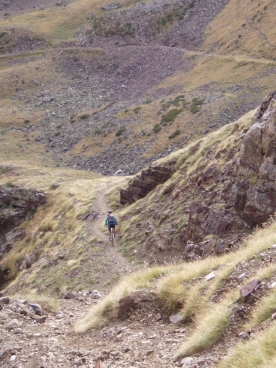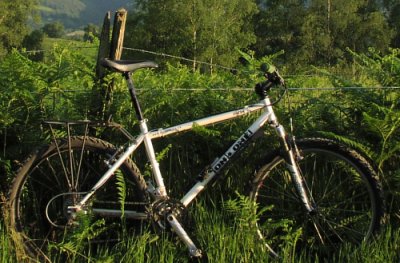Had loads of fun riding in various parts of Spain and France over the summer: (More on our trip to Spain)









Update 20th January 2004
Inbred is still going strong, Ive upgraded the forks to 2003 80mm Marzocchi Marathon S. These forks are great, slightly heavy but the bomb-proof construction and performance are well worth the weight penalty.
September 2003
Had loads of fun riding in various parts of Spain and France over the summer: (More on our trip to Spain)





On-one and Inbred logos
Designed in the UK and built in Taiwan, the Inbred is a well designed, good quality, CrMo steel frame at a reasonable price. On-One make several frames including a dirt jumper, BMX and single speed commuter. The Inbred comes in a variety of different guises including a disk specific, eccentric bottom-bracket version and a geared version; if youíre looking for something a little more up-market, itís also available in titanium.
Another key feature of these frames is the long top-tube and short stem combination. This design has been followed by several manufacturers over the last three or four years. The overall effect is to maintain the cockpit length (saddle to bar distance) but shift the riderís weight back on the bike. This gives the bike a more stable and confident feel, yet, with slightly adjusted riding technique, nimble handling. Iíve been riding this style of frame for four years and wouldnít go back.
The five-piece rear-triangle is similar to that found on DeKerf frames, giving good torsional and lateral stiffness whilst maintaining some vertical compliance. This means no loss of power with some of the harshness taken out of the trail.
Beefy, horizontal rear dropouts which provide about 1" of horizontal adjustment for the rear wheel, give plenty of scope for running a flip-flop rear hub with up to around a 4 tooth difference in freewheel sizes.
Set up can be anything between low and fast for XC racing and more upright free-ride / single track thrasher but above all, itís a bike to be ridden.
The frame weighs in at 4.75lb. Not super light compared with most aluminium frames, but then that is probably an unfair comparison. CrMo steel frames last indefinitely whereas aluminium frames have a limited lifespan mainly due to material fatigue. My CrMo Marin Team is now over 12 years old and still going strong, getting daily use commuting to and from work.
Finally there are rack/mudguard eyelets if needed and mounts for two water bottles.

On-One Inbred single speed
The absence of an expensive drive train allows some scope to spec. higher quality components for the rest of the bike. The King headseat is simply the best, as is the Thompson seatpost. The Surly flip-flop rear hub is a dependable performer at a reasonable price. It gives the option of running two freewheels, though Iíve not used this feature as I prefer to run the shortest possible chain in a 32x16 gearing. A non-shifting front chainring should be used and Blackspire do a nice solid 32t downhill chainring. I stuck with standard 175mm cranks though many single speed riders use 180mm. The bars are reasonably wide 1" XC risers on a short stem, giving quite an upright riding position and plenty of leverage when stomping up hills. Originally I had a 100mm, 10į rise stem, but I swapped this for a 90mm, 25į rise to give a nice upright, cruisy riding position.

Crank detail

Rear dropouts and hub detail
Brakes are Avid 2.0s. As far as rim brakes are concerned, you canít go past Avid: simple, dependable and relatively light. All three of my bikes have Avid brakes and they are way better than the Shimano parallel action V-brakes where the pivots wear out in a couple of seasons. The typically dry conditions in Western Australia donít really warrant disk brakes, though if you lived in wetter and muddier places, this could be worth considering on the front. If you were planning to run disks front and rear, it would be wise to get the disk specific Inbred frame. This frame has vertical dropouts so that the disk can be aligned correctly and the chain tension is adjusted using an eccentric bottom bracket - like on a tandem timing chain.
What makes the Inbred different from many other bikes is the length of the top tube. Itís amazing how much difference an inch makes. However, since I road my first Gary Fisher bike with his Genesis geometry, Iíve been a convert to this "long top-tube, short stem" style of geometry. One of the effects is to shift the body back a little on the bike - inspiring greater stability and confidence when descending. However you also gain greater rear wheel traction when climbing and the short stem greatly improves steering precision. The only slight drawback is that there is a little less weight on the front wheel, so you need to lean a little forward when cornering and take care to pull back on the bars rather than up when climbing - though, since the majority of climbing is done out of the saddle on a single speed, this really isnít an issue.
The bike has a pretty neutral feel, allowing you to chuck it around the single track. High-speed, sweeping corners are a real blast as are technical descents - the longer top-tube giving you plenty of confidence to let it rip.
The reasonably low bike weight and stiff rear-triangle gives good acceleration out of corners, and just concentrating on pedalling and not having to worry about shifting gears will tend to leave your mates on geared bikes in your wake.
32x16 seems the defacto standard gearing for single speeds. This ratio is ideal in Western Australia where most of the trails are pretty flat single track. The Inbred is a good climber, in that your legs will give out before you lose traction. Long open flats or pedally downhills will have you spinning like a loon if youíre trying to keep up with geared bikes, but youíre much better off freewheeling and taking in the view. Gently undulating single track or technical descents are the ideal tracks for single speeds, though itís actually quite surprising what gradients you can get up when 32x16 is your only option other than walking (though thereís nothing wrong with that!)
Riding a single speed (for an old fart like me) is like winding back the years to when you were ten or so, thrashing about on a knackered old bike and grinning a lot!
It is a long frame, so you might need to adapt your riding style a little if youíre not used to this type of geometry. However, Iím certain that once youíve tried it, you wont look back.
Highly recommended! Performance 5/5. Value 5/5.
| Frame | 2002 On-One Inbred DN6 CrMo Steel |
| Colour | White |
| Size | Medium - 18" centre to top |
| Forks | 2004 Marzocchi Marathon S (coil), 100mm travel |
| Wheels | Mavic F519 32h, 3X Sapin spokes, Surly flip-flop rear hub and WTB Laser disc front |
| Tyres | Front and rear: Michelin Mud 2.1" |
| Brakes | Front: Hope mini 185mm disc; Rear: Avid 2.0 brake and lever |
| Headset | Chris King |
| Stem | Titec BigAl 90mm, 0į rise |
| Bars | Answer Pro Taper XC 1" riser |
| Seat post | Thompson Elite 27.2mm x 410mm |
| Saddle | WTB, sstx comfort zone |
| Chainset | Bontrager Race Lite 4-arm 175mm Backspire 32t |
| Pedals | Specialised clipless |
| BB | Shimano UN72 (XT) 68mm x 113mm |
| Chain | Diamondback BMX |
| Cassette | Dicta 16t BMX freewheel |
| Other | I botle cage |
| Seat-tube centre to top | 18" |
| Effective top-tube length | 23.7" |
| Chainstay length | 16.4 - 17.5" |
| Head Angle | 71į |
| Seat Angle | 73į |
| BB Height | 11.9" |
| Standover | 29.4" |
| Head tube length | 105mm |
| Fork length | 400mm |
| Frame weight | 2.16kg (4.75lb) |
| Fork weight | 1.61kg (3.54lb)* |
| Bike weight | 10.95kg (24.1lb)* |
| * these weights are for the original setup without gears and with Manitou forks which are lighter than the Marzocchis | |